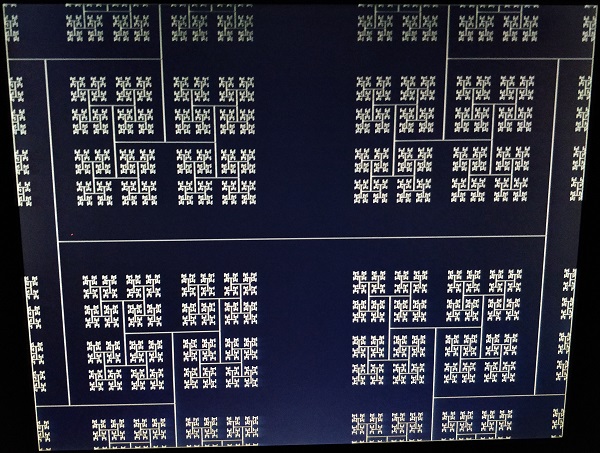
This program was my attempt to draw fractals on a VGA screen using Prof. Hunter Adam's VGA Library for the RaspberryPi Pico. The resources for the project include the C SDK User Guide, the RP2040 Datasheet and Prof. Hunter's website. I also used the Nature of Code series by Daniel Shiffman as a starting point for studying fractals.
According to Nature of Code's fractal page, the term fractal (from the Latin fractus, meaning “broken”) was coined by the mathematician Benoit Mandelbrot in 1975. In his seminal work “The Fractal Geometry of Nature,” he defines a fractal as “a rough or fragmented geometric shape that can be split into parts, each of which is (at least approximately) a reduced-size copy of the whole.” In short, a fractal is a shape which when divided into various parts, each part can represent the figure as a whole.
The repeated application of a rule to successive results is known as recursion. One of the most famous applications for recursion is the calculation of factorical. The factorial of a natural number is defined as:
\begin{align} n! &= n \times (n-1)! \\ 0! &= 1 \end{align}For instance, solving for 5! looks like: \begin{align} 5! &= 5 \times 4! \\ 5! &= 5 \times 4 \times 3! \\ 5! &= 5 \times 4 \times 3 \times 2! \\ 5! &= 5 \times 4 \times 3 \times 2 \times 1! \\ 5! &= 5 \times 4 \times 3 \times 2 \times 1 \\ 5! &= 120 \end{align}
Note: Recursions must always have a base case and that too at a reasonable depth, else it will cause a stack overflow error.
/*
* Parth Sarthi Sharma (pss242@cornell.edu)
* Code based on examples from Raspberry Pi Foundation.
* This code is an implementation of a line fractal
* on the Raspberry Pi Pico to draw a pattern. The pattern is developed
* by recursively calling a function by reducing a parameter until a base condition is met.
*/
#include <stdio.h> //The standard C library
#include <math.h> //The standard math library
#include "pico/stdlib.h" //Standard library for Pico
#include "hardware/pio.h" //The hardware PIO library
#include "hardware/dma.h" //The hardware DMA library
#include "pico/time.h" //The pico time library
#include "hardware/gpio.h" //The hardware GPIO library
#include "pico/multicore.h" //The pico multicore library
#include "vga_graphics.h" //The graphics library
#define HEIGHT 480 //Height of the VGA screen
#define WIDTH 640 //Width of the VGA screen
void drawLines(float x1, float y1, float x2, float y2){ //Function to recursively draw a line fractal
drawLine(x1, y1, x2, y2, WHITE); //Draw a line
//To figure out if it is a horizontal line or a vertical line
float dx = x2 - x1; //The x-length
float dy = y2 - y1; //The y-length
if (dx == 0 && dy > 4) { //If it is a vertical line with length greater than 4
drawLines(x1 - dy / 3, y1, x1 + dy / 3, y1); //Draw a horizontal line with (1/3)rd the length
drawLines(x1 - dy / 3, y2, x1 + dy / 3, y2); //Draw a horizontal line with (1/3)rd the length
}
else if (dy == 0 && dx > 4) { //If it is a horizontal line with length greater than 4
drawLines(x1, y1 - dx / 3, x1, y1 + dx / 3); //Draw a vertical line with (1/3)rd the length
drawLines(x2, y1 - dx / 3, x2, y1 + dx / 3); //Draw a vertical line with (1/3)rd the length
}
}
int main(){ //The program running on core 0
stdio_init_all(); //Initialize all of the present standard stdio types that are linked into the binary
initVGA(); //Initialize the VGA screen and functions
drawLines(40, 240, 600, 240); //Start by drawing a 560 pixel horizontal line
}

cmake_minimum_required(VERSION 3.13)
include(pico_sdk_import.cmake)
project(LineFractal-project)
pico_sdk_init()
add_executable(LineFractal)
pico_enable_stdio_usb(LineFractal 1)
pico_enable_stdio_uart(LineFractal 1)
pico_generate_pio_header(LineFractal ${CMAKE_CURRENT_LIST_DIR}/hsync.pio)
pico_generate_pio_header(LineFractal ${CMAKE_CURRENT_LIST_DIR}/vsync.pio)
pico_generate_pio_header(LineFractal ${CMAKE_CURRENT_LIST_DIR}/rgb.pio)
target_sources(LineFractal PRIVATE LineFractal.c vga_graphics.c)
target_link_libraries(LineFractal PRIVATE pico_stdlib hardware_pio hardware_dma hardware_adc hardware_irq pico_time pico_multicore)
pico_add_extra_outputs(LineFractal)